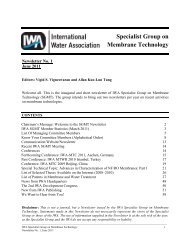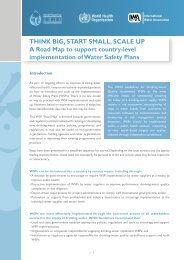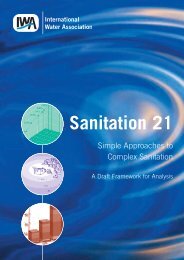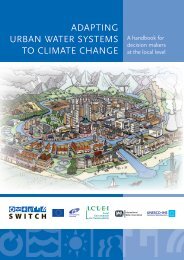Water and Energy - Draft Report of the GWRC Research ... - IWA
Water and Energy - Draft Report of the GWRC Research ... - IWA
Water and Energy - Draft Report of the GWRC Research ... - IWA
You also want an ePaper? Increase the reach of your titles
YUMPU automatically turns print PDFs into web optimized ePapers that Google loves.
<strong>GWRC</strong> <strong>Water</strong> & <strong>Energy</strong> - <strong>Draft</strong> report<br />
scrutiny (i.e., a given water treatment or wastewater treatment or<br />
storm water management alternative) define <strong>the</strong> global<br />
inventory.<br />
• Performance evaluation: Best practices, metrics, <strong>and</strong> indices<br />
have been developed to help utilities evaluate ongoing<br />
performance, through comparisons with <strong>the</strong>mselves <strong>and</strong> o<strong>the</strong>r<br />
utilities.<br />
• Impact assessment: Impact assessment methods are used to<br />
convert <strong>the</strong> inventory inputs/outputs into environmental (i.e.,<br />
GHG emissions), social (i.e., damages to human health) or<br />
economic impacts. Some methods or tools used for impact<br />
assessment include: life cycle assessment, least cost planning,<br />
embodied energy assessment, ecological footprint identification,<br />
conjoint analysis, social modelling, net present value analysis,<br />
least cost planning, life cycle costing, externalities valuation, etc.<br />
The attached figure, “Convention for integrated performance<br />
evaluation” helps to illustrate this.<br />
There is a need to identify <strong>and</strong> evaluate <strong>the</strong> models <strong>and</strong> methods<br />
used by urban water utilities to inventory process inputs <strong>and</strong> outputs,<br />
to evaluate performance, <strong>and</strong> to assess economic, environmental <strong>and</strong><br />
social impacts <strong>and</strong> risks <strong>of</strong> urban water energy management<br />
decisions. The models <strong>and</strong> methods help utilities define <strong>the</strong><br />
consumption <strong>of</strong> resources <strong>and</strong> <strong>the</strong> discharge <strong>of</strong> contaminants relative<br />
to urban water management, <strong>and</strong> to evaluate <strong>the</strong> impacts. There is a<br />
need to compare <strong>and</strong> contrast <strong>the</strong> models <strong>and</strong> methods <strong>and</strong> identify<br />
<strong>the</strong> gaps for <strong>the</strong> purpose <strong>of</strong> refining, syn<strong>the</strong>sizing, harmonizing, or<br />
developing new models <strong>and</strong> methods.<br />
Objectives Review <strong>the</strong> state <strong>of</strong> <strong>the</strong> science <strong>of</strong> <strong>the</strong> urban water utilities (drinking<br />
water, wastewater, reuse, <strong>and</strong> storm water) to manage energy<br />
consumption <strong>and</strong> greenhouse gas emissions. This will include a<br />
review <strong>of</strong> process-specific models, performance indicators, <strong>and</strong><br />
impact <strong>and</strong> risk assessment methods; syn<strong>the</strong>sis <strong>of</strong> <strong>the</strong> methods <strong>and</strong><br />
models generally used <strong>and</strong> accepted for evaluation <strong>of</strong> energy<br />
consumption <strong>and</strong> greenhouse gas emissions; description <strong>of</strong> how <strong>the</strong><br />
methods <strong>and</strong> models are used for decision making <strong>and</strong> risk<br />
evaluation; identification <strong>of</strong> gaps <strong>and</strong> research needs for refinement<br />
<strong>and</strong> harmonization, or development <strong>of</strong> more robust models <strong>and</strong><br />
methods; provision <strong>of</strong> a framework for proceeding with research<br />
Deliverables<br />
projects to meet <strong>the</strong> research needs.<br />
Provide a final report that summarizes existing process models,<br />
performance indicators, metrics, <strong>and</strong> indices, <strong>and</strong> impact assessment<br />
methods <strong>and</strong> tools, including a comparison <strong>and</strong> analysis. Summarize<br />
how <strong>the</strong> tools are currently used for energy management decision<br />
support <strong>and</strong> risk assessment. Develop a framework for harmonizing<br />
existing models, indicators, methods, <strong>and</strong> tools leading to a<br />
29

















